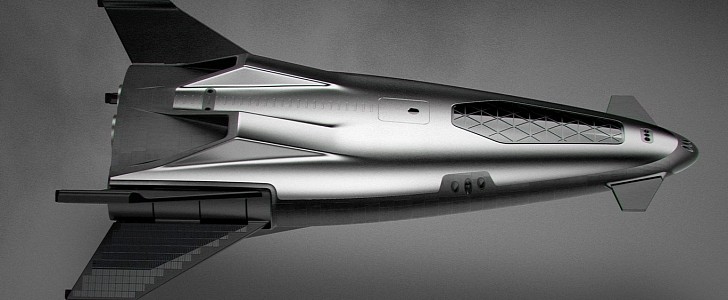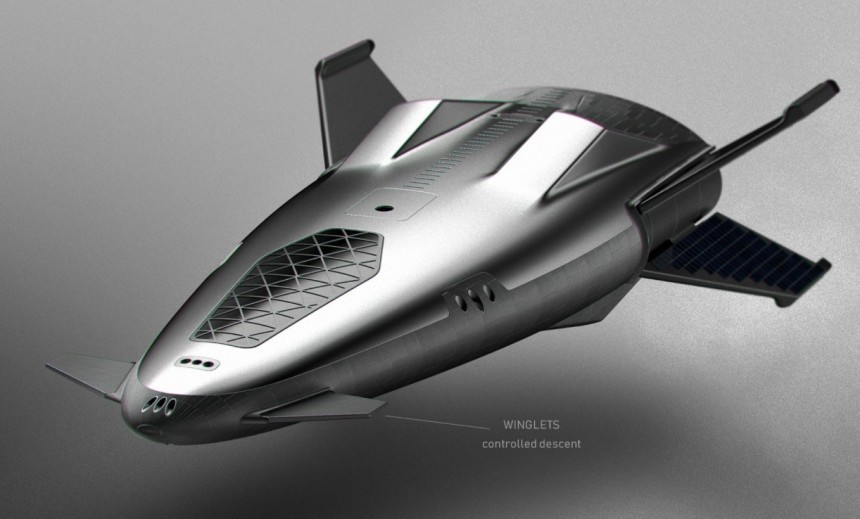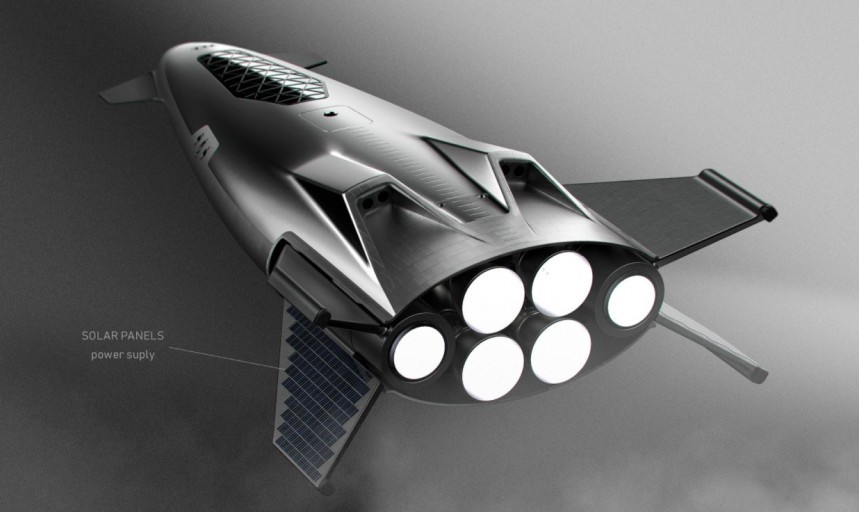The emergence of new companies usually spawns a long line of designers who want to show they’ve got the next winning design to take the world by storm. This one is dedicated to SpaceX.
It’s called the Starflight, and unlike other pieces I usually cover, this one just grabbed my attention a bit more than other spacecraft you may have seen round these parts. Why? It’s simple. Most designs of the sort are just for the visual effect of it all and don’t usually possess any further development. Not the case here at all.
Designer Rodrigo Magro Manas of Madrid, Spain, is a product and transportation designer who seems to give things more thought than your average human. I say this because the Starflight doesn’t just show off one hell of a sleek and beautifully crafted shell; the interior layout and even component functions have been taken into account too. We’re even shown landing sequences that the shuttle is supposed to initiate upon re-entry.
Personally, I won’t be getting into the details of angles and trajectories or how much fuel is used per pound of blah blah blah. That’s what NASA is for. I’m here to... I don’t know why I'm here really, maybe to make you chuckle a bit, I don’t know. As for the design, let’s have a look at why some of the aspects seen on this concept could be seen in the future, if they're not already used. After all, Rodrigo got his inspiration from somewhere. Maybe it’s just the Spanish air...
Let’s start with an aerial view of the ship. The first thing we notice is more of an airplane-like geometry and design instead of a rocket. That’s because this aircraft is meant as a service and cargo vessel meant to travel between the Moon and Mars once colonization has occurred. And since taking off and landing on a planet without much of an atmosphere is easier, no bulky equipment is needed, hence the smaller airplane-like shape.
The fins found throughout the vessel quickly pop into view. They have so many purposes that I wouldn’t be able to go through all their functions in depth in just one article, so I'll be brief. First, we have the two fins at the front. These two little winglets, as the designer calls them, are there to assist in steering the ship in a descent.
Between these winglets, we can see a few holes or nozzles. These and others found throughout the ship are thrusters; they are used for steering the vehicle while flying through space, as wings would no longer do the trick in a frictionless environment.
The fins at the rear, on the other hand, are a bit different. One of their main functions is that of being the vessel’s landing gear. As you land the craft, the wings on each side separate as to expose four points, offering stability. Yes, this means the craft remains vertical upon landing but also takeoff, which is a huge advantage for the massive thrusters mounted atop and underneath this behemoth. What, did you think those scoops coming out of the body are just there to look cool?
One important aspect of the rear wings is the placement of solar cells on the interior. This allows the vehicle to recharge electrical systems as you're picking up cargo or waiting for the next samples of that mind-blowing space dust you’ve heard about in the hood. Don’t worry about the law up here, they don’t have a precinct built yet.
We don’t have any idea what the inside environment may look like, but we do know how everything is compartmentalized. The very tip of the ship is for carrying cargo. Behind the cargo zone follows the crew bay, with this area extending underneath the huge, reinforced glass top you see. Behind the crew bay, another cargo area is revealed, followed by an oxygen chamber, and finally, the fuel tanks.
It looks cool and it even has some of the interior worked out; the steering and propulsion have also been taken into account. All that’s needed now are a few rocket scientists and some electrical engineers. Who knows, the way things have been moving lately, anything is possible.
Designer Rodrigo Magro Manas of Madrid, Spain, is a product and transportation designer who seems to give things more thought than your average human. I say this because the Starflight doesn’t just show off one hell of a sleek and beautifully crafted shell; the interior layout and even component functions have been taken into account too. We’re even shown landing sequences that the shuttle is supposed to initiate upon re-entry.
Personally, I won’t be getting into the details of angles and trajectories or how much fuel is used per pound of blah blah blah. That’s what NASA is for. I’m here to... I don’t know why I'm here really, maybe to make you chuckle a bit, I don’t know. As for the design, let’s have a look at why some of the aspects seen on this concept could be seen in the future, if they're not already used. After all, Rodrigo got his inspiration from somewhere. Maybe it’s just the Spanish air...
The fins found throughout the vessel quickly pop into view. They have so many purposes that I wouldn’t be able to go through all their functions in depth in just one article, so I'll be brief. First, we have the two fins at the front. These two little winglets, as the designer calls them, are there to assist in steering the ship in a descent.
Between these winglets, we can see a few holes or nozzles. These and others found throughout the ship are thrusters; they are used for steering the vehicle while flying through space, as wings would no longer do the trick in a frictionless environment.
The fins at the rear, on the other hand, are a bit different. One of their main functions is that of being the vessel’s landing gear. As you land the craft, the wings on each side separate as to expose four points, offering stability. Yes, this means the craft remains vertical upon landing but also takeoff, which is a huge advantage for the massive thrusters mounted atop and underneath this behemoth. What, did you think those scoops coming out of the body are just there to look cool?
We don’t have any idea what the inside environment may look like, but we do know how everything is compartmentalized. The very tip of the ship is for carrying cargo. Behind the cargo zone follows the crew bay, with this area extending underneath the huge, reinforced glass top you see. Behind the crew bay, another cargo area is revealed, followed by an oxygen chamber, and finally, the fuel tanks.
It looks cool and it even has some of the interior worked out; the steering and propulsion have also been taken into account. All that’s needed now are a few rocket scientists and some electrical engineers. Who knows, the way things have been moving lately, anything is possible.











